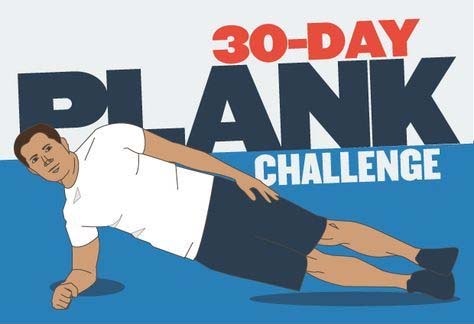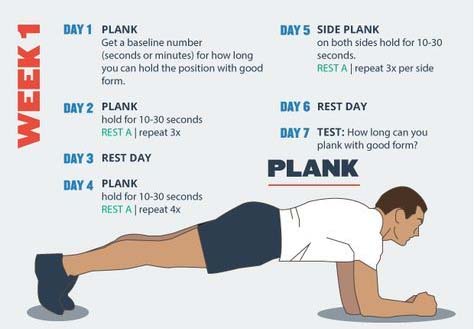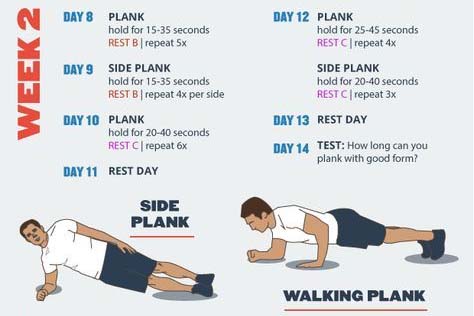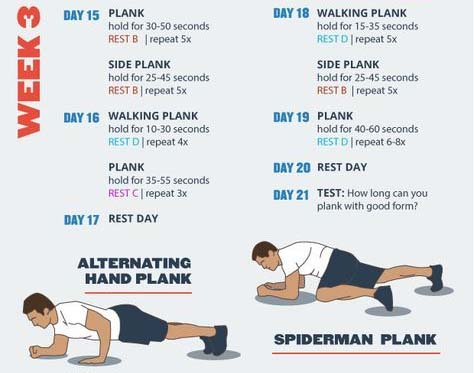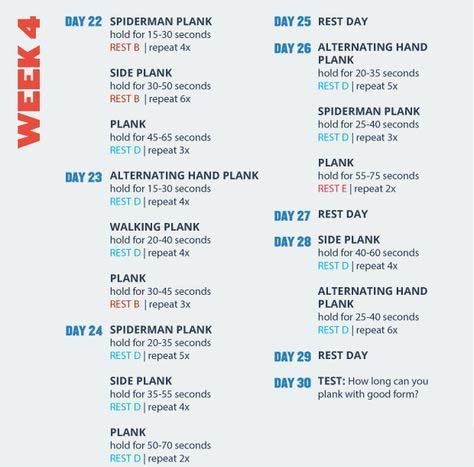Plank Challenge Workout
Today we will arrange a challenge for you in the form of a plank exercise that will help to pump all parts of the body, from abs to the back and shoulders
[wp_ad_camp_1]
The Plank – is a basic exercise that involves almost all the muscles of our body but most intensively the muscles of the abs (responsible for stabilizing the back, buttocks, thighs, pelvis and spine). This is our “abdominal” without which we will not be able to perform the other more complex exercises well: Even squatting and push-ups you need to keep your back and strain your abs.
The exercise itself is somewhat more complicated than it seems, and according to the person’s ability to perform it one can draw a conclusion about the level of his general training. If it cannot stand for 30 seconds in plank no need hurry up to start other exercises with free weights.
Is the Challenge Plank a warm up or part of a workout?
Warm up is articular and dynamic. In the first we knead joints but our heart maintains a calm rhythm. In the dynamic we connect not only rotational movements we pull the muscles the heart begins to work more actively.
The Plank does not fit any of these species. But you can and even need to add it as a separate exercise to your workout. Even if you are doing a complex, say, on your legs: You squat for a long time and then squat with a barbell letting your legs rest and your abs muscles work harder – a double benefit.
In most cases it is better to doing the plank in the middle or at the end of a workout, because you can spend a lot of energy on it. After this exercise you can relax, rest and stretch.
How to stand in the plank?
Sit down on the floor place your palms under your shoulders put your feet shoulder width apart or together. Despite the fact that the body is tense we keep our breathing calm and deep.
[wp_ad_camp_2]
Straighten the body in a straight line with natural deflections in the cervical and lumbar regions. Squeeze the buttocks and abs tighten the pelvis a little slightly turn it forward, straining the lower abdomen. The weakest point is the lower back make sure that it does not bend much and does not hurt in the plank.
The wider the legs will be, the more comfortable and easier it will be for you stay in plank so try to put them next to you over time.
If you can’t stand without a deflection in the lower back kneel down and try again to pull on the pelvis and tighten the buttocks. Take a position opposite the mirror so you can better control yourself.
Many still ask which plank is easier to stand on: Outstretched arms or elbows. It depends on the physiology of a particular person for some the shoulders are more lowered, for someone more raised, so these options are similar in severity
[wp_ad_camp_3]
How much do need to stand in the plank?
There is a conditional standard and “masthead” – at least 30 seconds. But you still need to focus on your feelings and capabilities. The very first place that starts to hurt in the bar is the lower back: We hold the muscles of the abs and as soon as he starts to get tired the tension will go to muscle back.
The first time you try, note the time. When your back starts to strain and you can’t keep your abs muscle, you need to stop.
If the plank is an independent part of the training then it is better to do it several times in a row with fixed approaches:
- For example, 30 seconds on the hands, then 30 sec. on the forearms, 30 sec. one side, then the second side then straight again.
If the plank is an insert between exercises then we do a fixed time once and then other exercises.
If the whole training consists of one plank, then a definite time for all cannot be indicated. But in general, 5-10 minutes to strengthen your body should doing this exercise.
[wp_ad_camp_4]
How can you complicate the plank?
There are two ways to complicate, which can be combined: Reducing the fulcrum and shifting the center of gravity. If we stand on the plank and extend our arm forward we have a completely different load on the body.
Read: also the article with Detailed Plank Exercises
How to understand that I can do more complex plank options?
Better to start by reducing the number of touch points. For example, if you extend your hand to your shoulder, you should keep the body line straight. Try to hold this position for several seconds, and then return to its original position.
Complication Plank Exercises (Static)
When you can be in the plank for a minute or more, try this option:
Keeping your body level, touch your arm with the opposite shoulder. This complication option will increase the load on the upper body and abdominal muscles, additionally including all small stabilizer muscles. At the first stage, touch the shoulder with your hand very quickly and eventually leave your hand near the shoulder for a few seconds.
Do not forget to alternate right and left hands in all kinds of plank.
Here, complication occurs due to raising the hand in front of you and shifting the center of gravity. Control the base position of the plank and raise your hand in line with the body for 1, 2, 5 seconds.
Later, when just an outstretched arm is easy for you, start stretching your opposite leg (arm), reducing the number of points of touch. So you will have more tension in all muscles.
You can also pull the knee to the elbow and back, making the exercise dynamic.
[wp_ad_camp_5]
Side Plank
The hardest version of the plank. You have to stand on one arm and leg, the first option is the classic plank is easier and better to start with it. Here the lateral abdominal muscles begin to work more and there is a strong load on the shoulder.
To complicate it but not by much, again we remove one point of support we put our feet on your feet.
You Can read More: How to do Side Plank
Important: always focus on your feelings. Gradually increasing pain from muscle tension is a normal condition for the side strip. But if you feel a sharp pain – there is already a reason to stop, double-check the correctness of the technique.





































